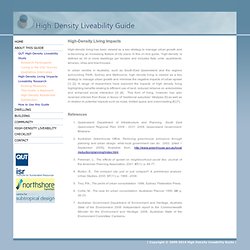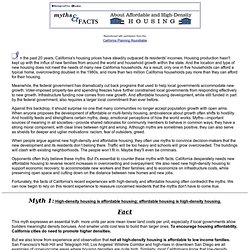

Map of Heavy Metal Concentration. Urban Sprawl: A Sim City 4 Demostration. ABC News: 30 Year Development for Greater Adelaide. 30 Year Development Plan for Adelaide. Adelaide's housing hub. Future for adelaides housing. Regional Victorian renters move more often than their Melbourne counterparts. Enzo Raimondo | 7 June 2012 According to data produced by the Victorian government, renters in regional areas of the state move more frequently than those in the metropolitan area.

In Melbourne the average tenancy duration in the December quarter last year was 25.9 months – i.e. just over two years. In regional Victoria the comparative number was a shorter 22.7 months – just under two years. These numbers are skewed by some very-long-term tenancies, as the median – the middle value – is much lower. In Melbourne the median tenancy duration was a short 17 months. The data also shows that, as would be expected, the smaller the dwelling, the shorter the tenancy. Interestingly, the largest homes, those with four or more bedrooms have a shorter tenancy – 16 months – compared with 18 for both two- and three bedrooms. The average duration of tenancy is certainly lower than it is for owner-occupied housing and that is one of the advantages for people who prefer to rent than buy. Department of Climate Change and Energy Efficiency - Home. Rebates & assistance - LivingGreener.gov.au.
Home Rebates & assistance Governments across Australia offer a range of rebates and assistance.

Select from the options below to find programs you may be eligible for. LivingGreener does not look after these programs. For any enquiries please contact the program owner directly. I live in: I'm a: I own or rent a: I'm interested in: energy water waste travel Rebates & assistance – 7 matching results Previous | 1 | Next EnergyElectricity feed-in tariffThe Solar Feed-in Scheme rewards eligible South Australian households and small electricity customers that install solar (photovoltaic or PV) renewable energy systems by paying them for the excess electricity they generate.Available: SAFor: Home owners; Renters; LandlordsType: House EnergyEnergy assistance for householdsEligible households across Australia can access the Home Energy Saver Scheme (HESS) to help reduce their energy use around the home and better manage the household budget.
Latest news. A Guide to Liveability in High-Density Environments. High-density living has been viewed as a key strategy to manage urban growth and is becoming an increasing feature of city plans.

In this on-line guide, ‘high-density’ is defined as 30 or more dwellings per hectare and includes flats, units, apartments, terraces, villas and townhouses. In urban centres in Australia, such as South-East Queensland and the regions surrounding Perth, Sydney and Melbourne, high density living is viewed as a key strategy to manage urban growth and minimise the negative impacts of urban sprawl [1] [2]. A range of researchers have explored the impacts of high density living highlighting benefits relating to efficient use of land, reduced reliance on automobiles and enhanced social interaction [3] [4]. This form of living, however, has also received criticism from those in favour of ‘traditional suburban’ lifestyles [5] as well as in relation to potential impacts such as noise, limited space and overcrowding [6] [7].
Myths & Facts About Affordable and High-Density Housing. N the past 20 years, California's housing prices have steadily outpaced its residents' incomes.

Housing production hasn't kept up with the influx of new families from around the world and household growth within the state. And the location and type of new housing does not meet the needs of many new California households. As a result, only one in five households can afford a typical home, overcrowding doubled in the 1980s, and more than two million California households pay more than they can afford for their housing.
Meanwhile, the federal government has dramatically cut back programs that used to help local governments accommodate new growth. Voter-imposed property-tax and spending freezes have further constrained local governments from responding effectively to new growth. Against this backdrop, it should surprise no one that many communities no longer accept population growth with open arms. Climate Debate Daily. 350.org. Paul Gilding: The Earth is full. 2006_Biddle_Bertoia_Greaves_Stopher.